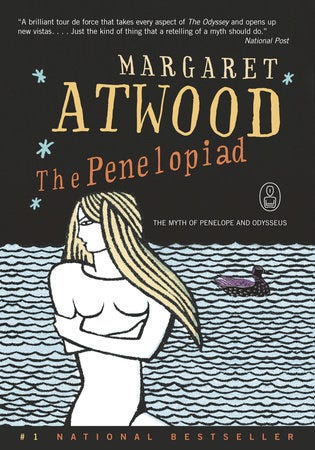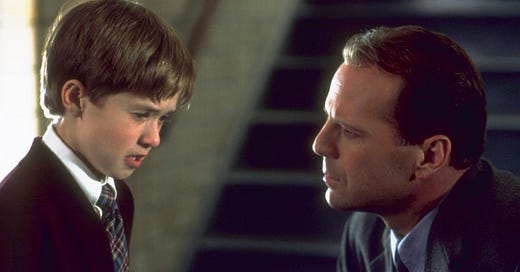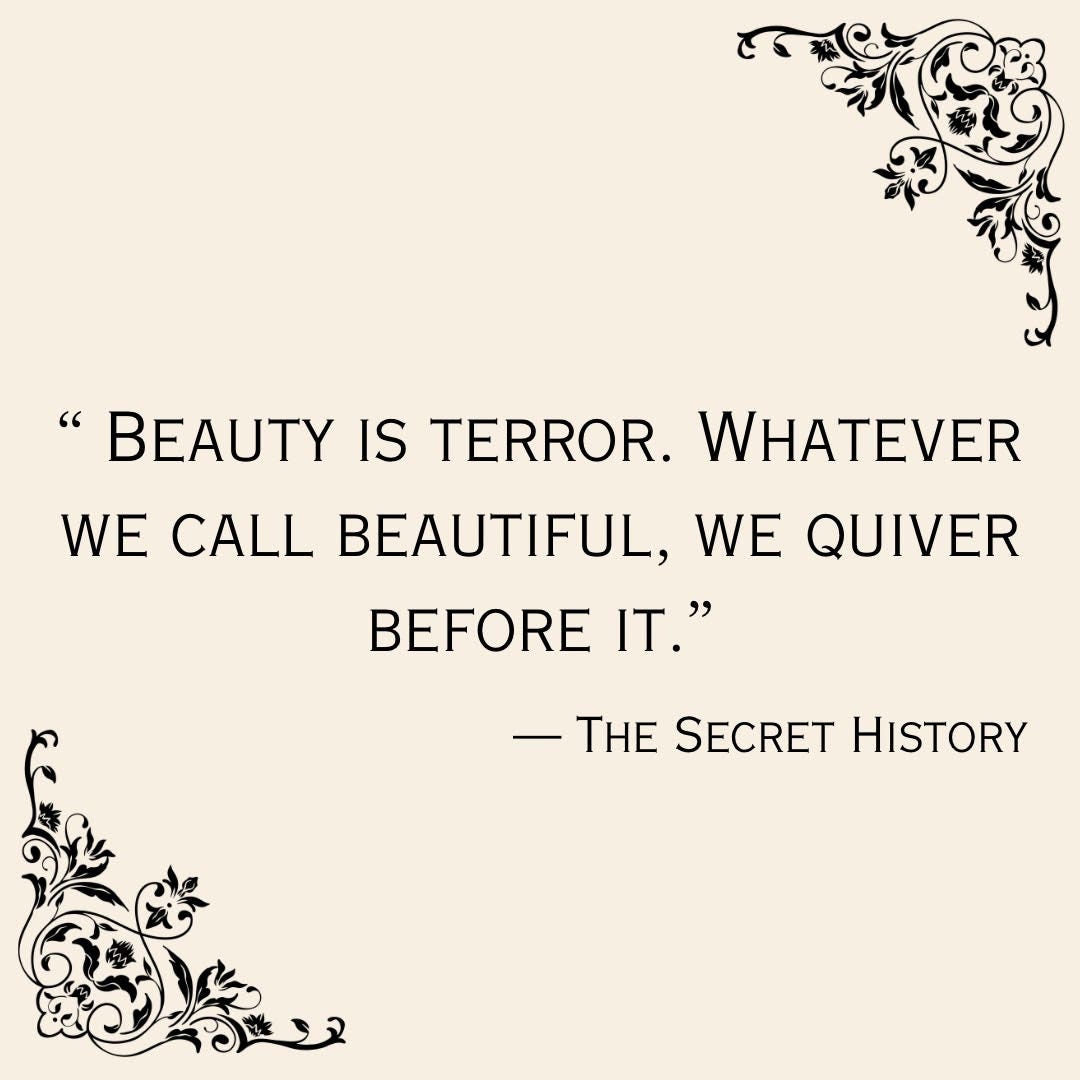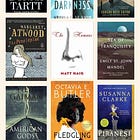Beauty is Terror: Gothic Literature and Film
American gothic fiction, an analysis of The Sixth Sense, and more
Readers, I love gothic fiction. I’m not quite sure how this obsession started - was it Jane Eyre? Rebecca? However it began, I do know where it ends for me: in the 18-19th centuries, confined to dark nights in European castles. But after reading The Secret History, I wanted to know - where is gothic fiction now?
To answer that question, first I had to figure out: what is gothic fiction?
You are reading The Novel Tea Newsletter, companion to The Novel Tea Podcast, where you’ll find book reviews, thematic literary analysis, and cultural commentary to help you thoughtfully engage with the world.
New posts come out every Tuesday. If you enjoy reading our work, and want to show your appreciation for the time and effort we put into it, please consider subscribing and sharing our newsletter with others.
Gothic fiction has many recognizable elements: haunted castles and abbeys, ghosts and monsters, nocturnal landscapes, morally ambiguous characters, and dark secrets. But at its core, I think gothic fiction is all about the juxtaposition of seemingly contradictory elements: fascination with fear, psychological with physical, graceful with grotesque, idyllic with monstrous, and beauty with terror.
In our episode on The Secret History, we discussed the meaning and significance of the line ‘beauty is terror’ in the context of the novel (and in last week’s newsletter, we talked about it in the context of dark academia).
In a way, that one line can serve as the thesis statement for gothic fiction. Because, importantly, terror and horror are very different. Ann Radcliffe, one of the first Gothic writers, said:
“Terror and Horror are so far opposite that the first expands the soul, and awakens the faculties to a high degree of life; the other contracts, freezes and nearly annihilates them.”
Devendra Varma, an expert on Gothic literature, wrote the following in his book The Gothic Flame: Being a History of the Gothic Novel in England -
“The difference between Terror and Horror is the difference between awful apprehension and sickening realization: between the smell of death and stumbling against a corpse.”
Terror is what sets gothic fiction apart from the horror genre.
Gothic Fiction in America
But what does a gothic novel become once you leave the deserted castles of Europe?
Allan Llyod-Smith, a scholar of American literature and culture, wrote in his essay “What is American Gothic?” that American Gothic is not an offshoot of European gothic, but its own genre:
“Rather than a simple matter of imitation and adaptation, substituting the wilderness and the city for the subterranean rooms and corridors of the monastery, or the remote house for the castle, dark and dangerous woods for the bandit infested mountains of Italy, certain unique cultural pressures led Americans to the Gothic as an expression of their very different conditions.”
The gothic genre continues to evolve, and books in the 21st century tackle new anxieties.
When the Reckoning Comes by LaTanya McQueen is an example of southern gothic, a genre that deals with and critiques religion, racism, poverty, and class. This book is about Mira, a Black woman who returns to her hometown for the wedding of her childhood friend, which takes place on a plantation (plantation weddings, unfortunately, are a real thing). While there, Mira and her friends are forced to reckon with the past. I’m excited to read this book - I’ve never read southern gothic before, so it’ll be interesting to look for similarities and differences when compared to Victorian gothic fiction.
The Hacienda by Isabel Cañas takes us outside of the US to Mexico: “During the overthrow of the Mexican government, Beatriz’s father was executed and her home destroyed. When handsome Don Rodolfo Solórzano proposes, Beatriz ignores the rumors surrounding his first wife’s sudden demise, choosing instead to seize the security that his estate in the countryside provides. She will have her own home again, no matter the cost. But Hacienda San Isidro is not the sanctuary she imagined.”
And this is just in North America. I’d love to learn more about gothic fiction from around the world - maybe in a future newsletter!
The Sixth Sense: A Gothic Film?
When I started writing this section, I thought, there’s no way that The Sixth Sense is a gothic film. But the more I read, and the more I thought about the film, the more I was convinced: The Sixth Sense is very gothic.
(Spoilers ahead!)
At the beginning of the movie, Malcolm (Bruce Willis) tells Cole (Haley Joel Osment): “You know, in the olden days in Europe, people used to hide out in churches. They would claim sanctuary.” This line, which calls to mind the origins of gothic fiction, helps frame the rest of the movie for us.
Now take a look at the most famous scene from the movie, with the script superimposed:
“A silent tension engulfs them both” is written into the stage directions, before either of them even speaks. This tension, which leads to terror, is built slowly and carefully throughout the film, leaving viewers with a vague sense of unease. And once we sit with the big reveal, we realize that though it may be terrifying to imagine ghosts lurking at every corner, there is also something beautiful about the closure that Cole gives them (if beauty is terror, then surely terror can also be beauty?).
Now let’s rewind a bit to look at the setting, an important component of gothic narratives. The Sixth Sense takes place in Philadelphia, one of America’s oldest modern cities, and one of the most haunted places in the country. Edgar Allan Poe spent several years of life in Philadelphia, its intense and mysterious atmosphere seeping into some of his spookiest tales. This version of Philadelphia, one with cobblestone roads, brick buildings, and ancient ghosts, is what we are shown in the first half of the movie, and it is this setting that introduces us to the movie’s themes.
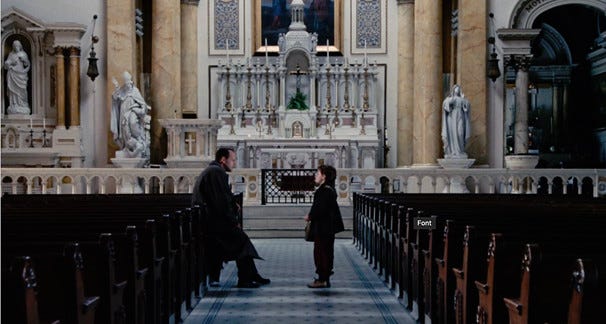
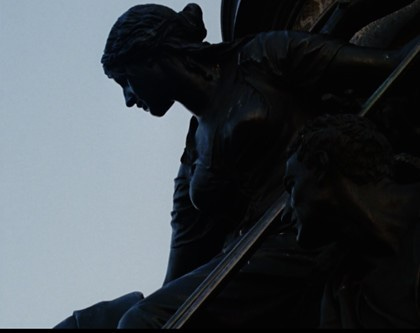
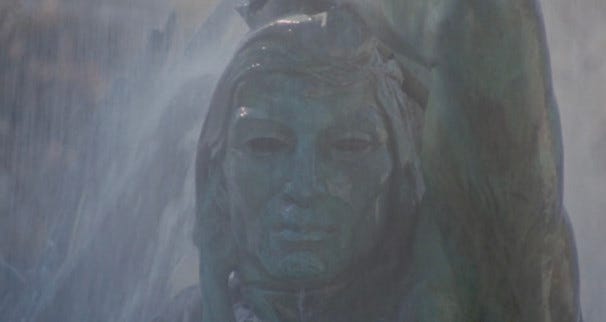

These visuals clue us into the fact that spaces and settings are meaningful in this film (for example, Malcolm spends a lot of time in his basement, whose door is mysteriously locked. Does the basement represent his subconscious? Is he trapped inside his mind?) As the movie continues, we learn about the violent histories of the different places Cole goes to: hangings in his school, an imprisoned slave in Derrick’s house, a burned down theater, and past abuse that occurred in his own home.
These are the elements which make the film veer slightly into “horror” territory - the fact that we can see what Cole sees eliminates some of the subtlety and tension that defines the gothic genre. But as the movie goes on, we start to recognize that the dead people that Cole sees are not really what the plot is about.
While on the surface, the movie is about ghosts, the core questions being asked are: “What is wrong with Cole?” “What happened to Malcolm and Anna’s marriage, and will they be able to fix their issues?” and “How can we ever move on from our past?” Psychological conflict and inner demons (two key features of gothic fiction) are what drives the story forward. And just in case we missed that link - Malcolm, the film’s protagonist, is a psychologist.
The underlying truth to the movie is hidden until the end - yet we get moments, clues that subconsciously signal to us that something is wrong: Malcolm never opens doors or makes objects move, and he is never seen directly conversing with anyone other than Cole. But the way scenes are cut, with just enough information for our minds to fill in the gaps, we assume he has just walked into a room, or a conversation has just ended, or Anna is still angry with him and therefore not speaking to him. So when the ultimate twist is revealed, we are blown away not because it is a shock, but because we are left thinking: how did we miss it this whole time?
In another world, I could easily imagine Daphne du Maurier, one of the powerhouses of gothic fiction, having written a version of The Sixth Sense as a novel or short story - just think of the way she infuses an urban atmosphere with tension and dread in Don’t Look Now, the proximity and effects of violence in The Flight of the Falcon, or the lingering spirits and hidden clues to the final secret revealed in Rebecca.
Have I convinced you? Do you think The Sixth Sense is a gothic film? Let us know in the comments!
— Shruti
Quick Picks
In this section, we’ll share books, movies, podcasts, TV shows, and other arts/media that we have been enjoying lately. Today we have some gothic-inspired picks from Neha.
TELEVISION | What We Do in the Shadows: Dracula meets The Office? I am unsure how to fully capture what this show does, but it’s a hilarious mockumentary following four vampire roommates living in Staten Island struggling to blend in with the modern world. Is it The Sixth Sense in terms of suspense, plot twists, and a chilling atmosphere? Absolutely not. Is it a comical and refreshing take on vampires and gothic fiction as we know it? Yes! I have only seen Season 1, but it’s been a great experience so far.
What We Do in the Shadows is available to stream on Hulu.
MUSIC | Think Of Me: Everyone who is familiar with gothic literature knows that The Phantom of the Opera is a classic. I was so enticed by Gerald Butler as The Phantom growing up and since then I have had a nostalgic love for the movie, the musical, and the novel. The song Think of Me from the 2004 movie was most played on my iTunes playlist for years, and recently I have been spending time listening to different renditions of the climax of the song. I get goosebumps listening to almost every one of them. Here’s a compilation video of some of the best renditions.
Related Posts You May Have Missed:
Up Next
Tomorrow, we will be discussing The Penelopiad by Margaret Atwood on the podcast through the themes of justice and persuasion.
